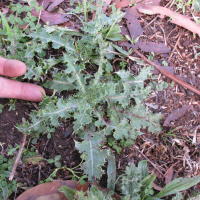Prickly sow-thistle
Sonchus asper
Sonchus asper, commonly known as prickly sowthistle or spiny sowthistle, is an annual or biennial flowering plant in the Asteraceae family. Native to Europe, Western Asia, and North Africa, it has become naturalized in various parts of the world. Prickly sowthistle is known for its spiny leaves and yellow, dandelion-like flowers. Here is an informative description of Sonchus asper, including its appearance, habitat, and ecological aspects:
Description:
-
Growth Form: Prickly sowthistle is an herbaceous plant that can grow as an annual or biennial. It typically reaches heights of 30 to 150 centimeters (12 to 59 inches).
-
Leaves: The leaves are deeply lobed and can have spiny margins. The upper surface of the leaves is green, while the lower surface may have a whitish appearance.
-
Stems: The stems are erect, hollow, and may have a reddish tint. They are often covered with coarse hairs.
-
Flowers: The yellow flowers of prickly sowthistle are arranged in clusters at the ends of branches, resembling those of dandelions. Each flower head is composed of ray florets.
-
Fruits: The plant produces small, cylindrical fruits containing seeds with a fluffy pappus that aids in wind dispersal.
Habitat:
Prickly sowthistle thrives in a variety of habitats, including disturbed areas, roadsides, fields, and waste places. It is adaptable to different soil types and can tolerate a range of environmental conditions.
Identification:
Identifying Sonchus asper involves recognizing its key features:
-
Spiny Leaves: The leaves are deeply lobed, and the margins can be spiny.
-
Hollow Stems: The stems are hollow and may have a reddish tint.
-
Yellow Flowers: The yellow flowers are arranged in clusters resembling those of dandelions.
-
Pappus: The seeds have a fluffy pappus that aids in wind dispersal.
Ecological Significance:
-
Invasive Potential: Prickly sowthistle can be invasive in certain settings, competing with native vegetation.
-
Wildlife: The plant may provide a food source for certain herbivores and attract pollinators.
Management:
Management strategies for prickly sowthistle may be necessary in areas where it is considered invasive. Control measures may include:
-
Mechanical Control: Regular mowing or cutting can help prevent the plant from producing seeds and reduce its spread.
-
Herbicides: Selective herbicides may be used for targeted control, but care must be taken to avoid harm to desirable vegetation.
-
Hand Removal: Hand pulling or digging out the plants can be effective for small infestations.
-
Prevention: Implementing preventive measures, such as practicing good weed hygiene and minimizing soil disturbance, can help prevent the establishment of prickly sowthistle.









